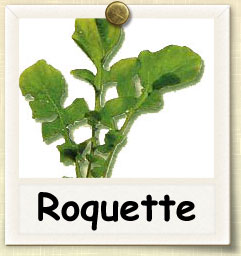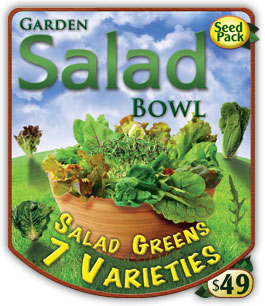|
Home > Guides > Vegetables > Arugula > Roquette |
|
How to Grow Roquette | Guide to Growing Roquette |
|
|
| |
 |
|
Overview |
|
|
|
|
|
| |
|
| |
This fast-growing cool-season salad green - often ready to harvest as early as 4 weeks after seeding - adds a tangy, peppery or mustard-like flavor to salads and mesclun mixes. |
|
| |
|
|
| |
Growing Guide
GROWING NOTES
Prefers rich humusy soil with pH of 6 to 6.8, but will tolerate wide variety of conditions. Evenly moist soil will help slow bolting.
Growth is low and compact until heat causes plant to bolt.
Forms a rosette of deeply lobed leaves. Plants become erect when heat induces bolting.
Flowers are edible.
MAINTAINING
Seeds germinate quickly even in cold soil. Plant as soon as soil can be worked in spring.
Avoid planting after other cabbage family crops.
Plant ¼ inch deep and 1 inch apart in rows, or broadcast alone or mixed with other greens. Gradually thin to 6-inch spacings using thinnings for salads.
Make new plantings every 2 to 3 weeks for a continuous supply until about a month before your average first frost date.
Slow bolting by reducing heat and moisture stress. Provide some shade for warm-season plantings.
Fast-growing plants are good for intercropping and relay cropping.
Often self-seeds. Is self-sterile and requires insects for pollination. Will not cross with other members of the mustard family.
|
|
| |
|
| |
|
|
| |
|
|
| |
Harvesting Guide
HARVESTING
Arugula is ready to harvest in 40 days.To harvest Arugula, pick off the outside tender leaves at the base of the plant. Leave the center growing point intact for future harvesting. Discard larger leaves as they tend to get tough and very bitter tasting. Leaves can also taste bitter in warmer weather. Eat fresh or cooked like spinach.
SAVING SEEDS
Your arugula will send up little white flowers with dark veins. Then little seed pods will form along the stem. These can be eaten fresh but beware, they are very spicy - they have a strong radish flavor. Next, the whole plant will start to turn brown. Cut off water at this point and let nature take its course. You may need to support the stems as they dry to keep them from falling over.
What happens next is up to you. Some people cover the stems with old nylon stockings or paper bags to catch the seeds as the pods open. I usually clip the stems and take the pods home when they're ready. You'll know they're ready when you hear a rattling sound when you shake the pods. I hang them upside-down inside a paper bag for a week or so.
Then comes the fun part - threshing. If your seeds are in a bag already, you can shake the bag or stick your hand in the bag and crumble the dried seed pods. You'll end up with a pile of tiny dark seeds mixed in with papery seed pod chaff. To separate this out, you can do it the old fashioned way, which is to put everything in a shallow pan and blow the chaff off the top of the pile. The seeds weigh more than the chaff, so they will stay put. Another way is to put them in a sieve that has holes bigger than the seeds, but smaller than the chaff and shake.
After you've separated out the seeds, you can store them in a zip-lock bag in the refrigerator, labeled with the date and year (for posterity's sake). Some folks store them in envelopes or jars. Either works as long as you keep them in a cool, dry environment.
|
|
| |
|
|
|
| |
|
|

|
|